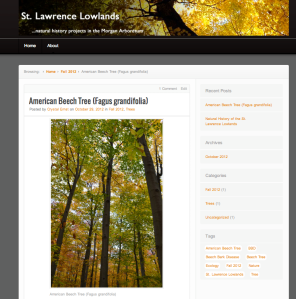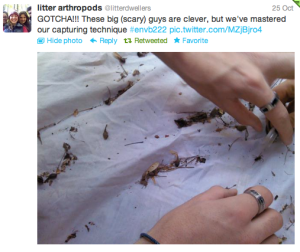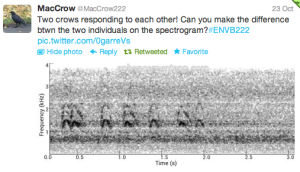As part of my field biology course this term, groups of students are working on research projects related to observing species in their natural setting - a ‘Natural History‘ project. Students are working in groups of 4-6, and each group is doing a focused project about a particular species (or group of species) including the following: American beech trees, sugar maple trees, hemlock trees, shelf fungi, aquatic macroinvertebrates, litter-dwelling arthropods, small mammals, the American crow and chickadees.
The first part of this project involves providing an overview of the natural history of their study species, and this overview is being released in the form of a scientific blog post. Starting today, and for the next three weeks, the nine blog posts will be released on the following site. (Today’s release is all about American beech Trees).
I have opted to use blog posts, as one form of social media, as a direct communication tool in this undergraduate course. This opens the work up to the broadest audience possible, and students have a lot more people to write for than just their instructors. I believe this will increase the quality of the writing since the stakes are quite high: experts on their topics will be able to read and comment on their posts. The students are encouraged to connect with the broader scientific community and seek input on their study species. Another reason to use social media is to allow the classroom work to move outside the walls of Academia. Students have told me that they are inspired by the idea of taking what they are learning and seeing how it is valued outside the (typically) insular classroom activities.
The use of social media in the classroom would not be complete without Twitter! The groups have set up twitter accounts, and within 48 hours of their posts going live, they will be tweeting a series of facts related to their study species! This is another informative, collaborative and fun way to seek input into their projects, and a way to bring what they have learned out to the broader community of biologists. Follow along! You can simply use the hashtag #ENVB222 to track the tweets related to the project. (by the way, you can follow the Beech tee group @BBDteam ). Here are a couple of examples of other tweets:
Students have already started to connect with scientists from other institutions - they are already feeling part of something bigger. For example, students in a field biology course at the University of Hull in the UK have connected with McGill students - the students from the two institutions can share connect, collaborate and share their experiences. This can be done easily through #hashtags:
So far this social media experiment in the classroom is inspiring, exciting, and leveraging real tools as a way to take the teaching and learning experience to a new level. However, it will only work if their blogs are read, critiqued, and discussed with the broader community. So, I encourage you to follow along and take part in this activity. You are all invited.
Community. Sharing. Collaboration. Outreach. Communication.
This is the power of social media.




This is a fantastic idea Chris, I hope it’s a success.
Pingback: Strategies for teaching a field biology course | Arthropod Ecology
Wow! This is so impressive! Makes me wish I had a Twitter account for the first time…
Pingback: Reflections: how social media has changed my life | Arthropod Ecology
Pingback: How “professional baggage” may be a key barrier in changing how we teach | Arthropod Ecology
Pingback: Teaching Innovation: Opportunities and Challenges | Arthropod Ecology
Pingback: » How “professional baggage” may be a key barrier in changing how we teach Teaching for Learning
Pingback: Slow Down | Arthropod Ecology
Pingback: A Paradigm Shift: How universities can support effective outreach | Arthropod Ecology
Pingback: Tweet tweet, twitter twitter: linking natural history and social media in a field biology class | Arthropod Ecology
Pingback: WiFi in the woods: new article on mobile technology and inquiry-based learning | The Bug Geek
Pingback: Social media, mobile technology and an outdoor classroom | Arthropod Ecology
Pingback: Social media, mobile technology and an outdoor classroom | Teaching for Learning @ McGill University
Pingback: How “professional baggage” may be a key barrier in changing how we teach | Teaching for Learning @ McGill University
Pingback: Why I Tweet - Ecology is not a dirty word